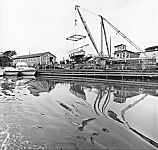A city's sanitation strategy is a deliberate, conscious decision. The demand for sanitation services simultaneously involves a demand for water works, water mains, sewers, and wastewater treatment works. A water supply is a city's lifeblood, but once brought into the city, water subsequently has to be removed. Lack of a sewer system creates a health hazard, but so does a system that discharges sewage into a city's water supply. The need for a sanitation strategy has faced cities at every time and place. Water and wastewater works represent public investments that an urban area must make if it is to survive. Strategies require choices, often defined in part by characteristics of a city's location.

|

|

|

|

|
Disinfection was introduced in 1916 by adding chlorine to the water supply at the pumping stations. An experimental filtration plant was introduced in 1928 to address continued turbidity. Chicagoans voted in 1930 to construct a major filtration plant on the South Side, but the Great Depression and World War II delayed its completion until 1947. Chicago's South Water Filtration Plant was the largest water processing facility in the world until the city's Central Water Filtration Plant was completed in 1964. In spite of the abundant quantity of fresh water at Chicago's front door, the city has invested a large amount in maintaining and improving the quality of that water.

|
Disposal has proven more difficult. In the early nineteenth century, the Chicago River ordinarily was little more than a creek, with banks lying two feet above the water. Normally sluggish, the river discharged large volumes of water in times of heavy rains or melting snows through its short main trunk into Lake Michigan. Chicago's random waste disposal methods led to a succession of cholera and dysentery epidemics. In 1852, Illinois's legislature empowered sewage commissioners to supervise the installation of sewers in the most densely settled districts and the digging of ditches in the remainder. In 1855 the Board of Sewerage Commissioners was formally charged with supervising the existing sewage and drainage scheme and planning a coordinated system for the future. Systematic sewage disposal and drainage was unknown in the United States, and in 1855 Chicago was in a position to become the first large American city to build a comprehensive sewer system.
Chesbrough designed a combined sewer system (one that collects wastes from both residences and streets) that emptied into the Chicago River. Drainage was to be accomplished by gravity, but Chicago's flat topography proved unfavorable to sewer construction. In reality, the task of constructing underground sewers required raising the city's grade. As sewer construction progressed away from the river, the streets had to be raised. The sewers were laid on top of the ground, then earth largely dredged from the river was filled in around them, covering them entirely. New, paved streets were constructed above the sewers.
The Chicago River evidently was innocuous for the first few years following installation of the new sewers, but soon the river became polluted, particularly the South Branch where much of the city's industry was located. Simultaneously, the city discovered that the Illinois and Michigan Canal pumps were moving the river's pollution into the canal. This important discovery meant that Chicago could avoid using Lake Michigan as a wastewater depository, thereby conserving the Lake Michigan water supply. In the late 1860s the canal was deepened yet again to enlarge its sewage handling capabilities, and additional pumps were installed. These enlarged facilities, completed in 1871, formally reversed the Chicago River's normal current, as the pumps pulled Lake Michigan water through the river to provide the canal's summit level.
With Chicago's continued growth, this system could not maintain the reversal under adverse weather conditions; the Chicago River, and often Lake Michigan, remained polluted. The solution was to enlarge the system, and officials recognized that it would cost less to dig a new channel than to enlarge the old one once more. In 1889 voters approved the Sanitary District of Chicago (now the Metropolitan Water Reclamation District of Greater Chicago) to implement the new channel scheme. This supragovernmental body proved necessary because the natural drainage area did not conform to Chicago's political boundary lines. Even with the annexation of adjacent suburbs, the affected area was much larger than the city of Chicago was ever likely to become. The strategy embodied in the Sanitary District was hardly revolutionary; it continued the same methods, only more effectively and with greater flexibility. Work began on the 28-mile Sanitary and Ship Canal in 1892 and was completed in 1900.
As new territory was annexed, two additional channels (the North Shore and the Calumet-Sag Channels) were added, but continued population and industrial growth would put significant pressure on the sewage-handling capabilities of the fixed-capacity channel system. Within the first ten years of operation it was clear that the district's works were not capable of handling the growing volume of Chicago's domestic and industrial wastes. In the 1910s the district began to construct sewage treatment plants to supplement the channel system. The decade of the 1920s saw the start of construction of the major treatment works that are the foundation of the city's current wastewater strategy. The Calumet sewage treatment works were placed in operation in 1922, followed by the North Side works (1928), the West Side works (1931), and the Southwest works (1939). A suit against the district was resolved in the U.S. Supreme Court in 1930 and resulted in a reduction of the district's diversion of water to reverse the river. This effectively reversed the district's approach; sewage treatment plants were forced supplemented by the channel system. By 1970 Chicago had the largest sewage treatment facilities in the world.
In 1972, Congress, in amendments to the Water Pollution Control Act, required that water pollution from all sources in urban-industrial areas be controlled. More than 90 percent of the district's wastewater was treated, but a heavy rainfall or quickly melting snow could still force the district to let raw sewage escape into the lake. The proposed solution was the multi-billion dollar Tunnel and Reservoir Plan, conventionally called " Deep Tunnel. " Phase I of TARP, the antipollution phase, which went into operation in 1985, involved the construction of 110 miles of tunnels to capture storm overflow and keep it in the system for processing. Phase II, the antiflooding phase, required an additional 21 miles of tunnels plus 3 large reservoirs.
Prior to the advent of public works projects in the 1930s, Chicago had spent more on sewage disposal-drainage than any other American city. Today the city has the largest water and sewage treatment works of any city in the world. Many lakefront cities are located at the mouth of a river, so the alternative of reversing a river's flow was, and still is, technologically available. Only Chicago has found this alternative economically feasible.
The Encyclopedia of Chicago © 2004 The Newberry Library. All Rights Reserved. Portions are copyrighted by other institutions and individuals. Additional information on copyright and permissions.